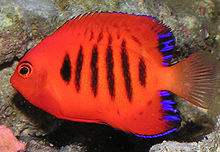- Flame angelfish
-
Flame angelfish 
Conservation status Scientific classification Kingdom: Animalia Phylum: Chordata Class: Actinopterygii Order: Perciformes Family: Pomacanthidae Genus: Centropyge Species: C. loricula Binomial name Centropyge loricula
(Günther, 1874)The flame angelfish, or Centropyge loricula, is a marine angelfish of the family Pomacanthidae found in tropical waters of the Pacific Ocean.
Contents
In aquaria
In captivity, this species feeds on a variety of food including live brine shrimp, frozen meaty foods as well as spirulina, seaweed sheets and pellets.
The flame angelfish is known to be shy upon introduction to an established aquarium (especially smaller specimens) but within a week will gain confidence and is then constantly seen grazing around live rock during the day. Angelfish may fight with other fish if challenged for space or kept with similar species in a small tank. Flame angels should be a final addition to a tank.
The Flame Angelfish is often considered reef safe. They will adapt to a captive diet quickly which will usually prevent them from consuming soft or stony corals. Individual specimens that do pick at coral or clam mantles are more often than not under fed or under nourished. They do not eat non-sessile invertebrates such as shrimp or crabs. The Flame Angelfish is one of the most popular of all the Centropyge.[citation needed] It is hardy enough for beginners and attractive enough for the seasoned aquarist because of its extremely bright, bold coloration. It is very aggressive towards its own kind but can be added to an established community aquarium as long as it is added close to last. It is not a good candidate for aquariums that do not use live rock for filtration or decoration.
Range
It is found in various reefs of Oceania, most common in Marshall, Line, and Cook Islands. The fish is also, although less commonly, found in the Hawaiian islands.
Species Description
Coloration is bright orange-red with a vertical elongated black spot and 4 or 5 bars on the sides, the posterior part of the dorsal and anal fins with alternating short purple-blue and black bands. Specimens from the Marquesas islands lack the vertical black bars.
Diet
In the wild, the Flame Angelfish has a varied diet consisting of algae and crustaceans. There are occasional specimens that live very long lives in reef aquaria, but the majority of these fish will often die for no apparent reason when they are older. This may be easily explained as many of the Centropyge family are predominately plankton eaters as juveniles and will switch to consuming it’s natural adult diet once fully grown. Sometimes all it takes is for an underfed individual to ‘test’ a food source. This being the case, angelfish are usually added to a well established tank and feed frozen mysis shrimp, meaty crustaceans such as shrimp and clam.
Aquaria information Flame angelfish Common names Flame angelfish Binomial name Centropyge loricula Aquarium conditions Salinity (SG) 1.020-1.025 pH 8.1-8.4 Alkalinity (dKH) 8-12 Aquarium care Reef safe With caution Temperament Semi-aggressive Care level Easy/Intermediate Traits Max length 6 in (15 cm) Range Christmas Island, Cook Islands, Hawai'i, Marshall Islands, Tahiti References
Categories:- IUCN Red List least concern species
- Pomacanthidae
Wikimedia Foundation. 2010.

